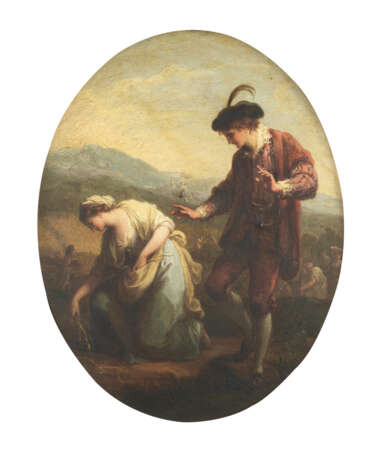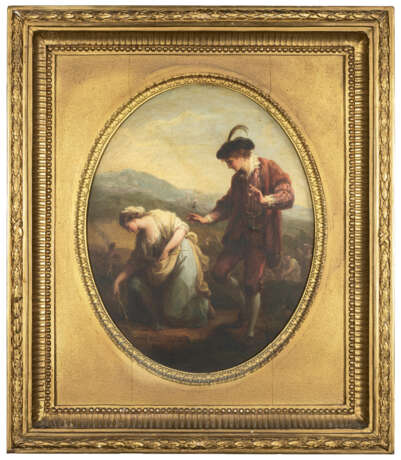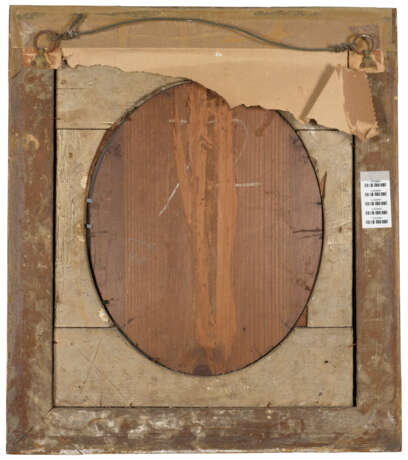ID 974874
Лот 48 | ANGELICA KAUFFMANN, RA (COIRE 1741-1807 ROME)
Оценочная стоимость
€ 30 000 – 50 000
Palémon et Lavinia
huile sur cuivre, ovale
31,9 x 25,7 cm. (12 1/2 x 10 1/4 in.)
Provenance
Probablement Sir Charles Fitzgerald Rushout (1840-1879), 3ème baronet Sizencot, Gloucestershire ; sa vente, Phillips, Londres, 9 décembre 1879 (vendu £94 à Grieg) (selon V. Manners et C. G. Williamson, 1900, op. cit. infra, p. 206).
Archibald Philip Primrose, 5ème Earl of Rosebery (1847-1929), Berkley Square, Londres, en 1900 (selon idem).
Collection du Hon. Robert William Morgan-Grenville (1892-1988), Royaume-Uni ; puis par descendance à son fils Robert Plantagenet Morgan-Grenville (1916-1993), Kenya ; puis par descendance à l'actuel propriétaire, Kenya.
Literature
V. Manners, C. G. Williamson, Angelica Kauffmann, R.A., her life and her works, New York, 1900, p. 206 et p. 226.
Special notice
These lots have been imported from outside the EU for sale and placed under the Temporary Admission regime.
Import VAT is payable at 5,5% on the hammer price. VAT at 20% will be added to the buyer’s premium but will not be shown separately
on our invoice.
Post lot text
ANGELICA KAUFFMANN, RA, PALEMON AND LAVINIA, OIL ON COPPER, OVAL
Previously only known through their engravings, Palemon and Lavinia and the three subsequent lots, Amelia and Celadon, Allegory of Prudence and Allegories of Mercy and Truth are important rediscoveries in the œuvre of Angelica Kauffmann (1741-1807). The fluidity of these compositions and the delicacy of their execution remind us why the artist's paintings were so coveted in 18th century aristocratic circles. Her work bridged the gap between the cult of sensibility and the emergence of neoclassicism.
Born in Switzerland and trained in Italy, Angelica Kauffmann moved to London in 1766. She quickly established herself in London as one of the most important and influential artists of her time, becoming one of only two founding female members of the Royal Academy. Although Kauffmann enjoyed great success as a portrait painter, she defined herself primarily as a history painter, an unusual designation for a female artist in the 18th century. At the time, history painting was considered the most distinguished category of academic painting and, under the leadership of Sir Joshua Reynolds (1732-1792), a close friend of Kauffmann's, the English Royal Academy sought to promote it to a native audience more interested in portraits and landscapes. The apathy of the British people towards history painting nevertheless motivated Kauffmann's decision to leave England after her marriage to the artist Antonio Zucchi (1726-1795) in 1781 and return to Italy where this genre was more sought after.
History painting, the depiction of human actions based on themes drawn from history, mythology and literature, required extensive study of writing, knowledge of art theory and more technical training including the study of anatomy from the male nude. The latter was forbidden to women at the time, yet Kauffmann managed to break through this gender defined barrier. It can be assumed that she replaced the study of the male nude with the study of ancient sculptures, but this enforced lack in her training explains why the male figures in her works are often considered more feminine than those of her peers at the Royal Academy.
The subject of Palemon and Lavinia is taken from the poetic work The Seasons by the Scottish writer James Thompson (1700-1748), the first part of which, The Winter, was published in 1726. The work, consisting of four parts - each dedicated to one of the seasons - was an immediate success. Thompson drew his inspiration from sources as diverse as Virgil (70-19 BC), Sir Isaac Newton (1642-1727), René Descartes (1596-1650) and Geoffrey Chaucer (c. 1345-1400). His poems are meditations on nature, alternating short stories and descriptive passages. Palemon and Lavinia appear in The Autumn; she a beautiful country girl and he the lord of the manor. Lavinia was forced to glean the fields because to support her impoverished mother, and Palemon, who saw her toiling, immediately fell in love with her. In her interpretation of the story, Kauffmann retains the timelessness of the poetic work by juxtaposing two styles of costume. Palemon is theatrically dressed in a sumptuous red silk suit reminiscent of the fashionable portraits of King Charles I (1600-1649) and his courtiers painted by van Dyck (1599-1641) in the previous century, while Lavinia is dressed simply, in the manner of a late eighteenth-century woman.
Kauffmann is far from the only person to have drawn inspiration from Thompson's work. Other representations of his verse can be found in the paintings of J. M. W Turner (1775-1851) and Sir Thomas Gainsborough (1727-1788) in England and the German translation served as the libretto written by Gottfried van Swieten (1733-1803) for the oratorio Die Jahrzeiten by the composer Joseph Haydn (1732-1809). In France Thompson was no less respected: Voltaire (1694-1778) praised the simplicity and love of humanity shown in the text, Rousseau (1712-1778) was plunged by his reading into a "rural delirium", and in 1793, at the beginning of the Terror, Madame Roland (1754-1793) recited his verses in her cell whilst awaiting the guillotine.
We would like to thank Dr. Bettina Baumgärtel for confirming the attribution to Angelica Kauffmann based on a first-hand inspection of the work, which she plans to include in her forthcoming catalogue raisonné of the artist.
| Техника исполнения: | Масло, Расписанный |
|---|---|
| Художественный стиль: | Старые мастера |
| Место происхождения: | Западная Европа, Европа, Швейцария |
| Категория аукционного дома: | Картины |
| Техника исполнения: | Масло, Расписанный |
|---|---|
| Художественный стиль: | Старые мастера |
| Место происхождения: | Западная Европа, Европа, Швейцария |
| Категория аукционного дома: | Картины |
| Адрес торгов |
CHRISTIE'S 9 Avenue Matignon 75008 Paris Франция | ||||||||||||||
|---|---|---|---|---|---|---|---|---|---|---|---|---|---|---|---|
| Предосмотр |
| ||||||||||||||
| Телефон | +33 (0)1 40 76 85 85 | ||||||||||||||
| Факс | +33 (0)1 40 76 85 86 | ||||||||||||||
| Условия использования | Условия использования | ||||||||||||||
| Транспортировка |
Почтовая служба Курьерская служба Самовывоз | ||||||||||||||
| Способы оплаты |
Банковский перевод | ||||||||||||||
| Часы работы | Часы работы
|





